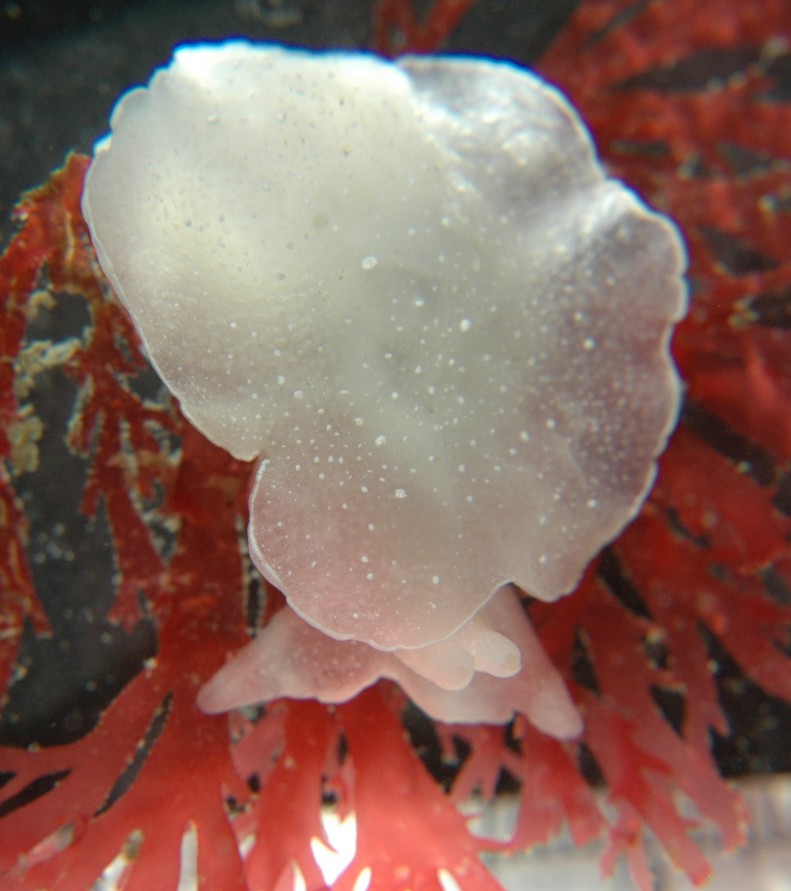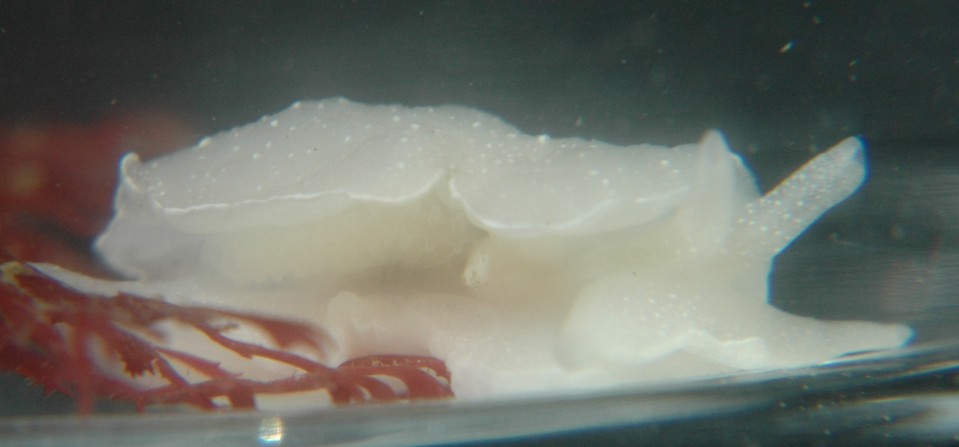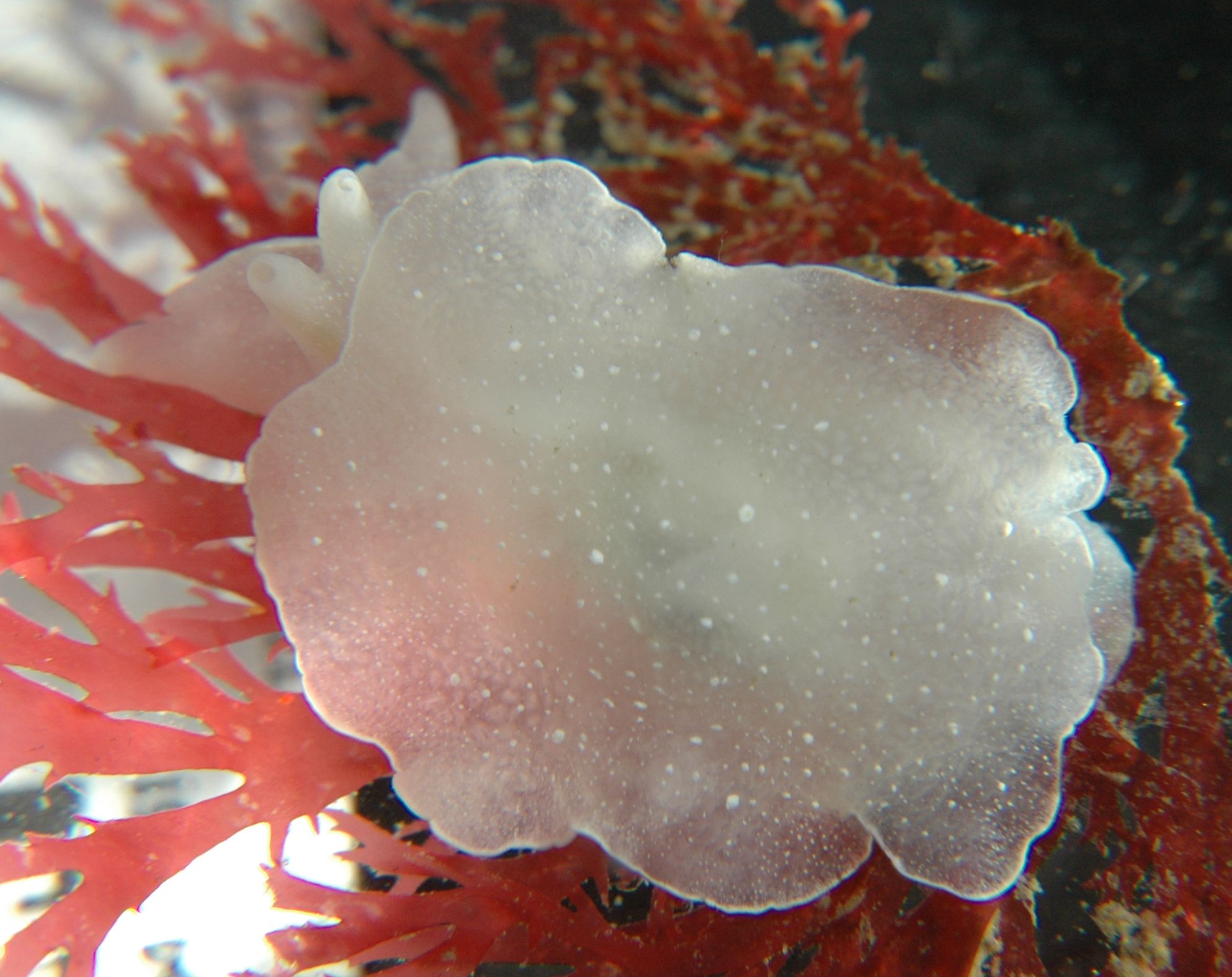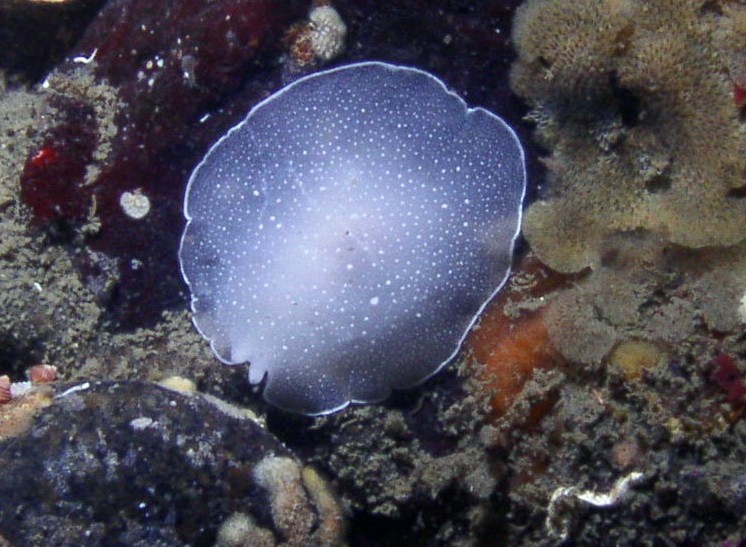Berthella chacei (J.Q. Burch, 1900)Common name(s): White berthella |
|
| Synonyms: Berthella californica, Pleurobranchus californica, Pleurobranchus denticulatus |  |
| Phylum Mollusca
Class Gastropoda Subclass Opisthobranchia Order Notaspidea Family Pleurobranchiidae |
|
| Berthella chacei from Coffin Rocks, WA. Length about 2.5 cm (Scale in background is mm). | |
| (Photo by: Dave Cowles,July 2005) | |
How to Distinguish from Similar Species: No other nudibranch-like animal in this area is white, with a lateral sheetlike extension above the foot and only one gill on the right side. Berthella californica is very similar but lives in California and south. Several dorid nudibranchs such as Doris odhneri look superficially similar but they have no lateral flap and their gills are a circle on the dorsum. Tylodina fungina is another Notaspidean, found in southern CA, but it is bright yellow. Note: Until recently this species was regarded to be Berthella californica. Ghanimi et al., 2020 showed that it is a different species, B. chacei.
Geographical Range: Point Craven, Alaska to Monterey, California; Pacific coast of Siberia, and Japan
Depth Range:
Habitat:
Biology/Natural History: This uncommon but striking species apparently preys on ascidians and perhaps on sponges. Little is known about this species. Some members of this family can repel predators with extremely strong acid secretions from glands in the dorsum.
LaForge and Page studied B. chacei
development. The
species lays its eggs in a coiled ribbon attached to the substrate
along
one edge. The egg ribbon is white, about 1 cm wide, and 1 mm
thick.
The egg capsules in the ribbon are oval, around 1.6 or 1.7 mm wide, and
contain 1-2 eggs each. At 11-12 C the eggs hatched as veliger
larvae
in 19 days. Its developmental pattern resembles that of
nudibranchs
more closely than does that of other pleurobranchoideans which have
been
studied. They also discovered that the snail-like shell which
the
larva has only becomes bilaterally symmetrical late in
development.
Some of the events that occurred when the larva settled and
metamorphosed
into the adult form included a rapid expansion of the mantle over the
shell
so that the shell became internal. They also lost the large
larval
velar lobes and began growing the rhinophore and oral veil.
The larva
also appeared to have an ospradium (chemosensory organ), though the
adult
does not.
| Return to: | |||
| Main Page | Alphabetic Index | Systematic Index | Glossary |
References:
Dichotomous Keys:Kozloff 1987, 1996 (as Berthella californica)
Smith and Carlton, 1975 (as Berthella californica)
General References:
Behrens,
1991
(as Berthella californica)
Morris
et al., 1980 (as Berthella californica)
Scientific Articles:
Ghanimi, Hessam, Jeffrey H.R. Goddard, Anton Chichvarkhin, Terrence
M. Gosliner, Dae-Wui Jung, and Angel Valdés, 2020. An integrative
approach to the systematics of the Berthella californica
species complex (Heterobranchia: Pleurobranchidae). Journal of
Molluscan Studies eyaa001, https://doi.org/10.1093/mollus/eyaa001
LaForge, Nicole L. and Louise R. Page, 2007. Development of Berthella californica (Gastropoda: Opisthobranchia) with comparative observations on phylogenetically relevant characters among nudipleuran opisthobranchs. Invertebrate Biology 126(4): 318-334 (Note: The species examined in this study is now known to have been B. chacei).
Web sites:
General Notes and Observations: Locations, abundances, unusual behaviors:
We have not often seen this animal around Rosario.

In this view of the right side, one can see the gill (and the gonopore
in front of it?) Photo by Dave Cowles, July 2005

In this view the rolled rhinophores can readily be seen.
Photo
by Dave Cowles, July 2005

An underwater photo by Kirt Onthank, July 2007
Authors and Editors of Page:
Dave Cowles (2005): Created original page